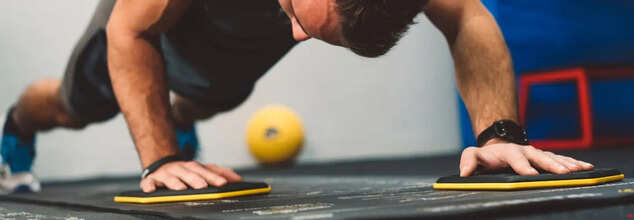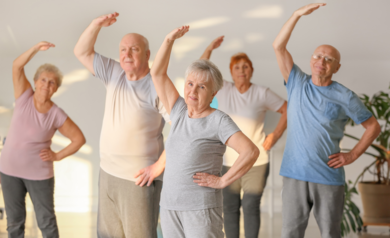- Health Conditions A-Z
- Health & Wellness
- Nutrition
- Fitness
- Health News
- Ayurveda
- Videos
- Medicine A-Z
- Parenting
- Web Stories
7 Effective Wrist Exercises to Boost Strength, Flexibility And Prevent Injury

Credit: Canva
Wrist strengthening exercises play a crucial role in building muscle strength, improving flexibility, and enhancing the range of motion in the wrist joints and tendons. They are particularly beneficial for athletes like boxers, gymnasts, and tennis players, as well as individuals at risk for conditions such as carpal tunnel syndrome. Regular wrist exercises can help prevent injuries and improve overall wrist health.
Many wrist exercises can be performed easily at home using light weights like dumbbells or household items such as water bottles or soup cans. However, it’s wise to consult your healthcare provider before starting any exercise routine to ensure it’s safe for your medical condition. A physical therapist can also guide you through the correct techniques to avoid strain or injury.
Finger Stretch
A simple stretch can effectively warm up your wrists and fingers before moving on to more demanding exercises. Begin by sitting comfortably with your elbow bent at a right angle. Make a fist, then slowly open your hand, stretching and spreading your fingers wide. Perform several repetitions with both hands. This exercise is also helpful during activities that require repetitive motion, like typing.
Wrist Extension With Dumbbell
For this exercise, sit in a chair with your forearm supported on a table and your hand hanging over the edge, palm facing down. Holding a 2- or 3-pound dumbbell, slowly lift your hand toward the ceiling, keeping your forearm steady. After fully extending your wrist, hold briefly, then lower it back down. Aim for two to three sets of 10–15 repetitions. Beginners can start without weights and gradually progress.
Dumbbell Wrist Flexion
Continuing with the dumbbell, flip your hand so your palm faces the ceiling. Flex your wrist upward, lifting the weight toward the ceiling, hold for a few seconds, and return to the starting position. Complete two to three sets of 10–15 repetitions. Like extensions, this flexion movement can also be practiced without weights by gently pulling your hand back with your other hand.
Prayer Stretch
To stretch the wrists and forearms, press your palms together just below your chin in a prayer position. Keeping your fingers together, slowly lower your hands until you feel a stretch along the inner arms. Hold for 15–30 seconds and repeat two to four times.
Steeple Stretch
Start in the prayer position and splay your fingers and thumbs apart as wide as possible, then bring your palms back together. Perform several repetitions throughout the day to maintain flexibility.
Wrist Supination With Dumbbell
Wrist supination involves rotating your wrist so your palm faces up. Sit with your forearm on a table and your wrist over the edge, holding a light dumbbell like a hammer. Slowly turn your hand until your palm faces the ceiling, hold, then return to the start. This exercise can also be done without weights.
Wrist Pronation With Dumbbell
The opposite of supination, pronation means turning your wrist so your palm faces downward. Hold the dumbbell vertically and rotate your wrist until your palm faces the floor. Perform two to three sets of 10–15 repetitions. For balanced strengthening, alternate between supination and pronation exercises.
Easy Restorative Yoga Pose Inspired By Dogs – You May Be Doing It Wrong!

(Credit-Canva)
If you are someone who does yoga or have even read about yoga and its poses, practices, etc., you may have noticed an interesting fact about the exercise. Many of the poses in yoga often have animal names in them, like cobra pose, bird pose, cat-cow pose etc. That is because, as a practice of health and healing, yoga pulls from our own surroundings. Nature has inspired many poses in yoga such as tree pose, mountain pose and many more.
One such pose is inspired by dogs. Downward Dog is one of the most famous yoga poses, but it's easy to do it wrong! Things like rounding your back, putting your feet too far apart, or pushing too much weight into your wrists can actually cause more of a stretch than you need, and even lead to injuries.
What Is Downward Dog?
Downward Dog (also called Downward-Facing Dog, or Adho Mukha Svanasana in fancy yoga language) is a basic yoga pose. You'll often see it used to connect other movements, like in a Sun Salutation sequence. It's also a way to rest actively, stretch your body, and make yourself stronger all at once. It gives you a moment to check in with how you're feeling during your yoga practice.
In this pose, your body looks like an upside-down "V" shape, or like a pyramid. Imagine a straight line going from the top of your head, through your back, and right up to the ceiling from your bottom.
How to Do Downward Dog the Right Way
Downward Dog usually isn't the first thing you do in a yoga session. It's best to warm up your muscles and joints a bit first. Once you're warmed up, follow these steps. according to the Cleveland Clinic:
- Put your hands right under your shoulders (about shoulder-width apart) and your knees directly under your hips.
- Spread your fingers wide and press firmly into your whole hand. Tuck your toes under, as if you're trying to grip the floor.
- As you breathe out, push your hips up and back, like someone's pulling your bottom towards the ceiling. This makes your body look like an upside-down "V."
- Focus on keeping your back flat and straight, not rounded. Let your head and neck hang loosely between your upper arms. Think about pushing the floor away from you with your arms to keep them strong.
- Pull your belly button in towards your spine to use your core muscles.
- Keep your legs straight. If it feels okay, try to gently drop your heels towards the floor, but don't force it down.
- Shift your weight a little between your hands and feet until you feel steady and comfortable in the pose.
- Stay in this pose for 10 to 15 seconds, and remember to keep breathing deeply.
- If the stretch feels too much, simply bend your knees a little and adjust your position until it feels better.
- When you're done, breathe out and either move into your next yoga pose or gently lower yourself down to the floor into Child's Pose.
Benefits of Downward Dog (and Who Should Be Careful)
Downward-Facing Dog gives you a full-body stretch and also strengthens many parts of your body, including your:
- Shoulders
- Arms (triceps and biceps)
- Stomach muscles (abs/core)
- Backs of your thighs (hamstrings)
- Bottom (glutes)
- Fronts of your thighs (quads)
- Hip muscles (hip flexors)
- Knee joints
This pose really improves how flexible you are and how well you can control your movements. It also acts as a moment of active rest. Because your head is lower than your heart, it increases blood flow to your head and upper body.
Skipping Weekday Workouts? This Diabetes Study Says Its Totally Fine Only 'If You Do This'

Credits: Canva
Can you really pack all your weekly exercise into the weekend and still get the benefits? If you have diabetes, the answer might surprise you. A new study published in the Annals of Internal Medicine reveals that people with diabetes who follow a "weekend warrior" workout routine squeezing all their recommended physical activity into one or two days have a significantly reduced risk of premature death. Specifically, they were 21% less likely to die from any cause and 33% less likely to die from heart disease, compared to those who don’t exercise at all.
The term "weekend warrior" refers to individuals who do not or cannot exercise daily but instead cram their full weekly dose of recommended activity into one or two sessions typically on weekends.
For adults, the general guideline is at least 150 minutes of moderate-intensity physical activity per week. That can include brisk walking, light cycling, yoga, dancing, or even heavy gardening.
And yes, that entire quota, according to this new study, can be done in just one or two days and still deliver significant health perks.
Researchers from Harvard T.H. Chan School of Public Health analyzed health and exercise data from nearly 52,000 adults with diabetes, collected between 1997 and 2018 through the U.S. CDC’s National Health Interview Survey. They then compared this with death certificate data from 2019 to draw their conclusions. Here’s what they discovered:
Diabetics who exercised one or two times per week and met the total 150-minute weekly target had a 21% lower risk of all-cause mortality than non-exercisers.
Their risk of death from heart disease was 33% lower.
Even those who exercised more frequently — in three or more sessions a week — saw a 17% reduced overall death risk and 19% less risk of dying from heart disease but the most unexpected insight? Weekend warriors may actually have a slight edge over regular exercisers when it comes to reducing heart-related mortality.
Why Its Important for People With Diabetes to Workout?
If you’re living with diabetes, physical activity isn’t just about burning calories or building muscle. It has a direct impact on blood sugar control, insulin sensitivity, and long-term cardiovascular health.
- Lowers blood glucose levels during and after activity
- Improves insulin sensitivity, which helps your body use insulin more efficiently
- Reduces HbA1c levels, even without weight loss
- Helps lower LDL (bad) cholesterol and raise HDL (good) cholesterol
- Improves mental health, reduces stress, and boosts energy
In short, movement is medicine especially for people managing a chronic condition like diabetes.
When and How to Work Out With Diabetes?
For people using insulin, the timing of workouts matters. The best time to exercise is typically 1 to 3 hours after a meal, when blood sugar levels are higher. If your blood glucose is under 100 mg/dL before a workout, eat a small snack or piece of fruit first to avoid hypoglycemia. Check your blood sugar before and after workouts — especially intense ones.
Be prepared, carry glucose tablets or candy, and wear a medical alert bracelet.
And remember, the goal isn’t perfection, it’s consistency. Whether it’s dancing, hiking, lifting weights, or long weekend walks, movement in any form helps.
What this study ultimately confirms is that flexibility matters. You don’t need to work out daily to gain life-saving benefits especially if weekday schedules make that hard.
Even if your job, caregiving duties, or chronic fatigue prevent you from regular weekday workouts, you still have a powerful tool in your hands. Just 2 to 2.5 hours of physical activity spread over Saturday and Sunday can significantly lower your risk of death and improve how your body handles diabetes.
It’s important to note: this study was observational, meaning it can’t prove cause and effect only association.
The researchers call for more comprehensive studies that track physical activity across entire days, including movement at work or during commutes. Still, this study adds to the growing body of evidence that any movement is better than none, and how you structure it can still produce powerful benefits.
If you’ve been feeling guilty about not being able to hit the gym every day, this research offers a hopeful message: even weekend workouts count, and in some cases, may be just as good or better. So the next time your weekend opens up, lace up those shoes, roll out your yoga mat, or head to the trail. Your body and your heart will thank you.
Natural Ways To Combat Insomnia - Study Finds These 3 Exercises To Be Best For Sleep

(Credit-Canva)
One of the best ways to relax is by sleeping, after a tiring day of work, all a person needs is their bed. However, not being able to sleep is a big concern. Many people suffer from insomnia or sleeping disorders that stop their bodies from resting properly. So how does one tackle this?
It's well-known that regular physical activity can improve your sleep, but what kind of exercise is best when you're really struggling to get enough rest? New research published in the BMJ journal points to a few specific activities that might be especially helpful for beating insomnia.
Natural Way to Combat Insomnia
Many people experience chronic insomnia, which can seriously affect their health and daily life. While talking to a therapist about sleep problems is often the best approach, this new research suggests that certain exercises could be a good natural option, especially for those who can't easily access therapy.
Past studies on exercise and sleep often treated all physical activity the same or looked at short-term versus long-term exercise. This new research, however, looks at different types of exercise separately to see which ones are most effective.
Exercise and Sleep
To find out which exercises might lead to better sleep at night, researchers looked at many studies involving people with sleep difficulties or diagnosed insomnia. They compared different approaches, including therapies like counseling and massage, as well as various forms of exercise:
- Yoga
- Tai Chi
- Walking or jogging
- A mix of heart-pumping exercises and strength training
- Strength training on its own
- Heart-pumping exercises combined with therapy
- Other mixed heart-pumping exercises
Yoga Shines Brightest for Sleep Improvement
As expected, therapy had broad and lasting positive effects on sleep. But among the exercises studied, yoga appeared to be the most promising. It was linked to:
- Almost two more hours of total sleep time
- Nearly a 16% improvement in how efficiently people slept
- About a 30-minute reduction in the time it took to fall asleep
Walking or jogging was connected to a noticeable improvement in how severe insomnia was. Tai Chi was associated with over 50 more minutes of total sleep time and about a 25-minute quicker time to fall asleep. The researchers concluded that these findings highlight how much exercise can help in treating insomnia.
It's important to remember that this study has some limitations. Many of the studies included in the review had some design or method problems, and some involved only a small number of people. Also, it was hard for some experts to fully review the new research because it didn't directly show or link to the specific studies it looked at.
Exercise Helps You Sleep Better
So, why does exercise improve sleep? Experts suggest that physical activity can boost your energy levels during the day, improve your mood, and sharpen your thinking. These effects can help counteract the negative impacts of insomnia.
More specifically, walking or jogging might help you sleep better by reducing stress hormones and increasing sleep-promoting hormones. For yoga, its focus on controlled breathing and body awareness may increase levels of a brain chemical that helps you relax and fall asleep. Tai Chi might also support better rest by encouraging calmness and improving emotional control.
Tips for Using Exercise to Improve Your Sleep
If you're struggling with insomnia, it's a good idea to talk to a sleep expert or a doctor specializing in sleep. They can provide personalized advice. While this study points to certain exercises as being particularly helpful, experts encourage people to try different activities to see what works best for them. The key is to choose something you enjoy and can stick with regularly. Remember, exercise isn't just about making you tired. It's about improving your mind and body so you're better able to get the sleep you need.
© 2024 Bennett, Coleman & Company Limited




